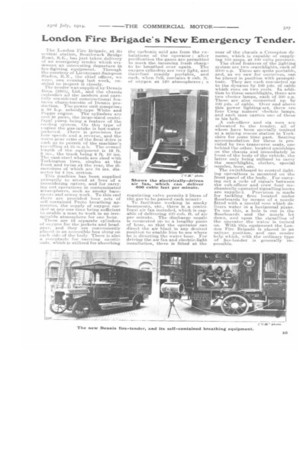London Fire Brigade's New Emergency Tender.
Page 21

If you've noticed an error in this article please click here to report it so we can fix it.
The London Fire Brigade, at its central station, Southwark Bridge Road, SE., has just taken delivery of an emergency tender which evidences an interesting departure in lire-fighting equipment. Through the courtesy of Lieutenant Sampson Sladen, R.N., the chief officer, we were, one evening last week, enabled to inspect it closely.
The tender was supplied by Dennis Bros. (1913), Ltd., and the chassis embodies all the modern and carefully considered constructional features characteristic of Dennis proAuction. The power unit comprises a 50 h.p. subsidy-type White and Popp° engine. The cylinders are cast in pairs, the large-sized centrifugal pump being a feature of the eeoling system. On this type of engine the gas-intake is hot-waterjacketod. There is provision for four speeds and a reverse, and the worm-gear ratio of the final drive is such as to permit of the machine's tic yelling at 25 m.p.h. The overall length of the equipment is 19 ft. ms., the track being 6 ft. 10 ins. The cast-steel wheels are shod with Torkington tires, singles at the front and twins at the rear, the dimensions of which are 34 ins. diameter by 4 ins. section.
This machine has been supplied primarily to attend at fires of a smouldering nature, and for carrying out operations in contaminated atmospheres, such as smoky .basemeets and sewer work. To this end there are provided four sets of self contained Proto breathing apparatus, the supply of oxygen carried at any one time being sufficient to enable a man to work in an irrespirable atmosphere for one hour. There are 12 separate cylinders of oxygen for the jackets and headgea r, and they are conveniently played in an accessible box slung on each side of the body. There is also a receptacle for carrying caustic soda, which is utilized for absorbing the carbonic acid gas from the exhalations of the operator ; after purification the gases are permitted to meet the incoming fresh charge to be breathed over again. The oxygen cylinders are very light, and therefore readily portable, and each. when full, contains 6 cub. ft. of oxygen at 120 atmospheres ; a
regulating valve permits 3 litres of the gas to be passed each minute. To facilitate working in smoky basements, etc., there is a centrifugal air fan included, which is capable of delivering 400 cub. ft. of air per minute. The discharge nozzle is connected up to a lengthy piece of hose, so that the operator can direct the air blast in any desired position to enable him to see where he is directing the water hose. For driving the air fan and electric-light installation, there is fitted at the rear of the chassis a. Crompton dynamo, which is capable of supplying 100 amps. at 100 volts pressure.
The chief features of the lighting system are two searchlights, each of 3000 c.p. These arc quite portable, and, as we saw for ourselves, can be placed in position with promptitude. They are each con fleeted up to the dynamo by 100 yds. of cable which rung on two reels. In addition to these searchlights, there are two cluster lamps, each of 300 c.p. These are also connected up by 100 yds. of cable. Over and above this power lighting-set, there are four Ceag miners' electric lamps, and each man carries one of these in his belt.
A sub-officer and six men are allocated to the tender, all of whom have been specially trained at a mining rescue station in Yorkshire for sonic time past. Seating accommodation for these is provided by two transverse seats, one behind the other, located amidships on the chassis and immediately in front of the body of the vehicle, the latter only being utilized to carry the searchlights, clothes, special nozzles, hose, etc.
The switchboard to control lighting operations is mounted on the front panel of the body. For carrying out a code of signals between the sub-officer and crew four mechanically-operated signalling horns are supplied. Provision is made for tackling fires located under floorboards by means of a nozzle fitted with a special rose which delivers water in a horizontal plane. To use this, a, hole is cut in the floorboards and the nozzle let down, and upon the signalling of the operator the water is turned on. With this equipment the London Fire Brigade is placed in an unique position, and can render help which, with the ordinary type of fire-tender is generally impossible.


























